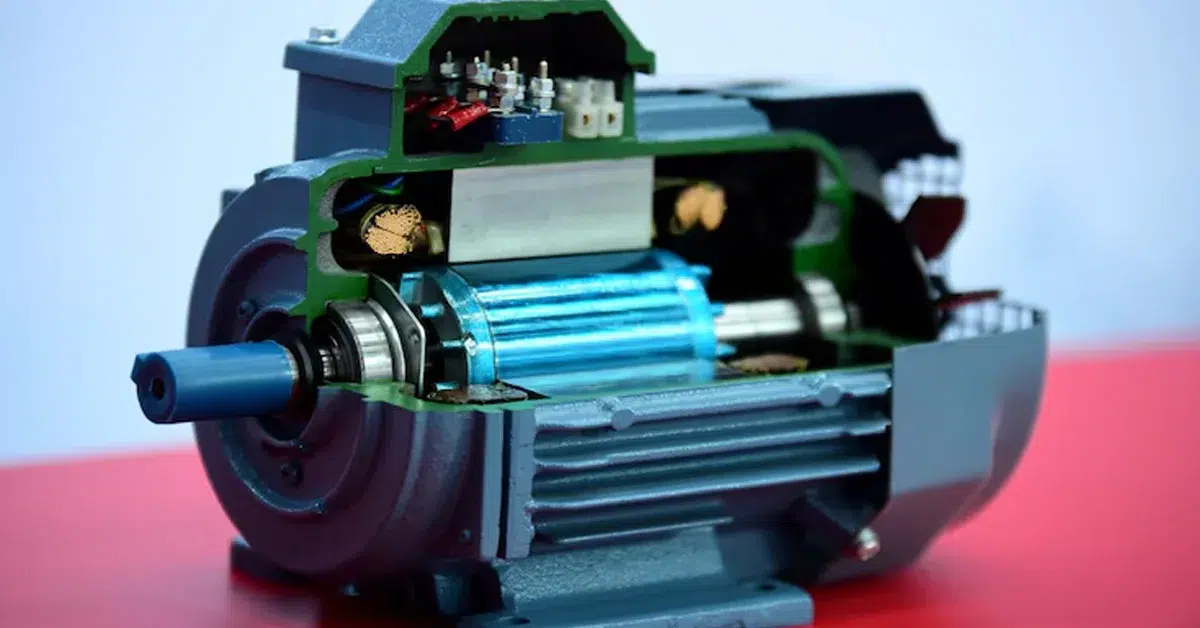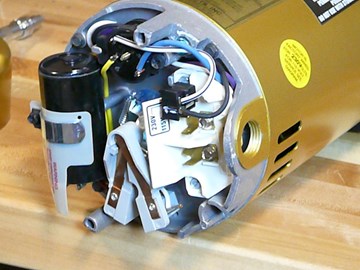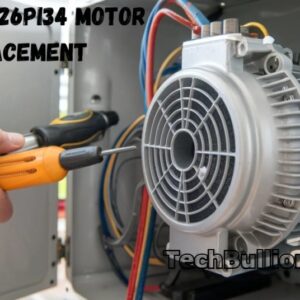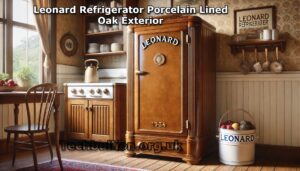Imagine your morning routine being disrupted by your water heater. The cold shock of a lukewarm shower can make anyone grumpy! Perhaps you’ve found the reliable hum of your A.O. Smith 326PI34 Motor Replacement into an annoying clank, leading you to one conclusion: it’s time for a replacement. Let’s make sure your hot water is back in business with this complete guide on motor replacement!
Understanding the A.O. Smith 326PI34 Motor
The A.O. Smith 326PI34 Motor Replacement plays an essential role in the functioning of A.O. Smith water heaters. Without it, your heating system would struggle to operate efficiently. But what do you know about this vital component? Let’s break it down.
1. Overview of the Motor
The 326PI34 is an electric motor, designed specifically for use in water heating systems. Its main job is to rotate the water pump, ensuring that hot water circulates throughout your home. Efficient operation helps maintain consistent water temperatures and supports overall energy usage.
2. Common Issues Associated with the 326PI34
Like any device, the 326PI34 can face a variety of problems. Here are some common issues:
- Overheating: This can lead to premature failure.
- Noise: Unusual sounds can indicate that the motor is wearing down.
- Vibration: Excessive vibration often points to misalignment or mounting issues.
3. Signs That Replacement is Needed
So, how do you know when it’s time to replace the motor? Here are a few telltale signs:
- If you notice decreased water flow.
- Increased energy bills without explanation.
- Constantly running but failing to heat water.
- Frequent on-and-off cycling of the motor.
4. Key Specifications of the Motor
Understanding the specifications is crucial when considering a replacement. Here’s a handy chart:
| Specification | Details |
| Motor Type | Electric |
| Voltage | 115V |
| Power | 1/6 HP |
| Speed | 1725 RPM |
| Typical Lifespan | 5-10 years |
| Replacement Cost | $100-$200 |
With a lifespan of 5 to 10 years, it is important to keep an eye on your motor’s performance.
5. Comparison with Similar Motors
When comparing the 326PI34 to similar motors, you might find some differences in specifications and performance. Some motors may offer higher horsepower or additional features. However, it’s important to evaluate if those extra capabilities are truly necessary for your heating system. Will they deliver better results?
6. How the Motor Operates in the System
The 326PI34 motor works hand-in-hand with other components to create an effective heating system. Essentially, it drives the water pump, which circulates water through the heating system. This ensures that the water reaches your faucets and appliances at the right temperature. You can think of it as the heart of your heating system. If the heart isn’t functioning well, the entire system can falter.
“The A.O. Smith 326PI34 is a reliable choice for many homeowners, but regular maintenance is key.” – Industry Expert
A.O. Smith has established itself as a leader in water heating technology. By understanding the 326PI34 motor and how it functions, you can ensure your system runs smoothly and lasts longer. Keeping up with maintenance is crucial.
As a final note, whether you’re dealing with a motor replacement or just routine checks, knowing what to look for can save you time and money. Keep this information in mind as you navigate your water heating needs.
Gathering Your Tools and Parts

When tackling a task like replacing a motor, it’s crucial to have the right tools and parts on hand. There’s a certain sense of satisfaction that comes from completing a project yourself. Yet, nothing can mess up your plans more than starting the job only to realize you forgot a vital tool. So, let’s dive into what you need to gather before beginning your motor replacement journey.
1. Essential Tools for Replacing the Motor
To handle a motor replacement safely and effectively, you’ll need several essential tools. Here’s a quick list to get you started:
- Screwdrivers: Both flathead and Phillips.
- Wrenches: Adjustable ones help a lot.
- Pliers: A sturdy pair is a must.
- Utility knife: To cut any necessary materials.
- Multimeter: For checking electrical connections.
These tools may vary depending on your specific motor model. Always refer to your product manual for exact specifications.
2. Recommended Replacement Parts
When it comes to replacement parts, not all options are created equally. You want to opt for quality and reliability. The most important replacement part is, of course, the motor itself. Other parts might include:
- Capacitors: Often needed when replacing motors.
- Wiring: Ensure it’s in good condition.
- Mounting hardware: Necessary for securing the motor.
3. Safety Equipment to Use
Before you start working, don’t overlook safety equipment. After all, accidents can happen in a flash. Here’s what you should have:
- Gloves: To protect your hands.
- Goggles: Shield your eyes from debris.
- Dust mask: Avoid inhaling anything harmful.
4. Considerations When Purchasing Replacement Parts
When purchasing parts, quality is king. Here are a few considerations:
- Compatibility: Confirm that parts fit your specific model.
- Warranty: Look for parts that come with one.
- Reviews: Read feedback from other users.
Also, remember that buying from authorized dealers helps avoid counterfeit parts. It’s tempting to go for the cheaper options, but it won’t be worth it in the long run if they fail.
5. Where to Buy A.O. Smith Parts
Finding A.O. Smith parts isn’t hard if you know where to look. Many authorized dealers sell these parts online or in-store. Websites like:
- OEM Parts Websites: Good for factory parts.
- Local Hardware Stores: Check their plumbing sections.
- Online Marketplaces: eBay and Amazon often have listings.
6. Estimated Budget for This Replacement
Now let’s get into the money aspect. It’s good to have a rough idea of what you’ll need to spend:
| Item | Estimated Cost |
| Tools | $30 – $50 |
| Replacement Motor | $100 – $200 |
| Safety Gear | $20 – $30 |
As you can see, preparing your budget is essential. Having the right tools and parts ready can make the job quicker and easier, minimizing downtime. By planning, you set yourself up for a successful motor replacement.
Step-by-Step Motor Replacement Guide

Replacing a motor can feel like a daunting task. However, with the right approach, you can manage it safely and efficiently. Let’s break down the process step by step. This guide will help you understand how to replace the motor in your system, ensuring that everything works smoothly afterward.
1. Turn off the Power Supply
Before you do anything else, it’s crucial to turn off the power to your motor. Safety is the priority here. Working on a live circuit can lead to serious injuries or even fatalities. So, flick that switch off. You’ll thank yourself later.
2. Disconnect the Old Motor
Next, it’s time to disconnect the old motor. This may involve loosening wires or unscrewing bolts. Remember, it’s like untying a knot. You need to be gentle. Do not yank or pull at things too hard; this can cause more damage.
Take pictures or notes during this process. They can serve as a reference for how everything was connected before.
3. Install the New Motor
Now, you get to the exciting part of installing the new motor. Align it carefully as per the installation guide. It should fit snugly into the designated space without forcing it. Use the bolts or screws that held the old motor.
4. Reconnect Wiring Safely
With the new motor in place, it’s time to reconnect the wiring. Ensure you match the connections according to the notes or pictures you took. This is the part where double-checking is most important. Are all the wires in place? Are they tightly secured? Don’t rush through this. Every little connection counts.
5. Test Functionality
After everything is connected, it’s time to test functionality. Turn the power back on and check if the motor operates correctly. This is where you’re putting your work to the test. If it doesn’t work, don’t panic! Go back and review your steps. What might be wrong? Maybe a wire is loose or incorrectly placed.
6. Clean Up the Workspace
Once you’re satisfied with the performance of your new motor, it’s time to clean up your workspace. Remove any tools, old parts, or debris. A clean area makes future repairs easier and safer.
Notes to Keep in Mind
- Each step should be done carefully to avoid damage or injury.
- Double-check all connections before powering the unit back on.
Data on Motor Replacement
The typical time for a motor replacement is about 1-2 hours. If you’ve been without hot water, you may experience an average downtime of 4-6 hours. Keeping track of these times can help in planning your day accordingly.
“Taking your time during the installation will save you headaches later.” – Plumbing Professional
Final Thoughts
By following this structured approach, you can ensure that you don’t miss any critical steps in the motor replacement process. Each part of the procedure is essential. Understanding how to do it properly makes all the difference in achieving a successful installation.
Now, take a breath! You’ve got this. Taking one step at a time makes even the most complex tasks manageable. Plus, having a reliable motor will reward you with peace of mind in the future.
Troubleshooting Common Issues Post-Replacement

After you replace a motor or any essential appliance, it’s common to face a few teething issues. What can you do if things don’t seem right? Let’s take a look at some common problems and how you can troubleshoot them.
1. Unusual Noises Coming from the Motor
Hearing strange noises? That can be unsettling. Usually, these sounds can indicate that something isn’t quite right. Is it a humming, rattling, or grinding noise? Here’s what you should check:
- Check for Obstructions: Sometimes, debris or foreign objects can get stuck in the motor.
- Wiring Issues: Loose or frayed wires could cause electrical sounds. Inspect them for any damage.
- Installation Problems: If the motor isn’t properly aligned, it could vibrate noisily. Ensure it is mounted securely.
2. Water Heater Not Heating Properly
Frustrating, isn’t it? No hot water can throw off your day. Inspect your water heater by doing the following:
- Power Supply: Is everything plugged in and functioning? Sometimes the simplest issue is just a bad connection.
- Thermostat Settings: Check the settings to ensure they are set properly. Sometimes, it’s a simple adjustment.
- Inspect the Heating Element: A broken heating element is often the culprit for lack of heat.
3. Electrical Issues
If the motor isn’t receiving the proper electrical supply, issues will arise. Here’s how to determine if electrical problems are to blame:
- Check Your Circuit Breaker: A tripped breaker could stop the motor from working.
- Inspect Voltage Levels: Use a multimeter to check if the voltage levels are correct.
- Look for Loose Connections: Any loose wires could cause intermittent power supply issues.
4. Signs of Leaks After Motor Replacement
Noticing puddles? Leaks are something you can’t ignore. They can cause significant damage. Here’s what to do:
- Inspect Seals and Gaskets: Ensure all seals are tight and not worn down. This is a common issue after replacements.
- Look for Damaged Fittings: Sometimes, newly installed fittings can be overlooked.
- Monitor Your Water Consumption: An unexplained spike might indicate a hidden leak.
5. Routine Checks to Perform
How often should you check for problems? Regularly! Here’s a simple checklist for routine maintenance:
- Inspect the wiring and connections.
- Check for any signs of corrosion.
- Listen for any unusual noises.
- Keep an eye on water levels and temperature settings.
6. When to Call a Professional
Let’s face it, some problems are beyond DIY fixes. If you find any of these issues:
- Major Electrical Problems: If you’re unsure or uncomfortable working with electricity, call an expert!
- Persistent Leaks: If leaks continue despite your efforts, professional help is often the best choice.
- Repeated Heating Issues: If your heater keeps failing, it’s time for a technician to diagnose it.
Most issues can be resolved with quick troubleshooting, so don’t panic. Remember to document any problems to discuss with a technician if needed. Understanding common issues, like noises, heating problems, or leaks, is a step in the right direction. Did you know? Common issues break down like this: noises (30%), heating problems (25%), and leaks (20%). If all else fails, you may need to consider professional help. Remember, safety first!
Routine Maintenance for Long-lasting Performance

Keeping your water heater in good shape is crucial for enjoying hot water without worry. This section dives into the importance of regular maintenance and how it impacts the performance and longevity of your unit.
Importance of Regular Maintenance
Think about it: you wouldn’t skip changing the oil in your car, would you? The same logic applies to your water heater. Regular maintenance is like giving your unit a wellness check. It ensures everything is running smoothly, preventing costly breakdowns. Consistent maintenance can prevent premature motor failure. Why risk a cold shower when simple checks can keep everything working? Remember
“Regular maintenance is the secret to a long-lasting water heater.” – Home Maintenance Expert
Checklist for Regular Inspections
Establishing a routine can help you stay ahead. Here’s a quick checklist to guide your inspections:
- Check for leaks around the unit.
- Inspect the anode rod (replace if less than 1/2 inch thick).
- Examine the temperature setting (should be around 120°F).
- Test the pressure relief valve.
- Flush the tank to remove sediment buildup.
Doing these things every 6 to 12 months can save you from potential issues down the line.
Signs That More Than Just the Motor Might Need Attention
If you notice strange noises like popping or banging, your heater might have sediment buildup, which can cause problems. Additionally, if your water is discolored or smells bad, that’s a signal it’s time to check more than just the motor.
Best Practices for Upkeep
Staying on top of maintenance is key. Here are a few best practices:
- Keep the area around the heater clear. This promotes airflow and safety.
- Insulate pipes. This prevents heat loss.
- Schedule professional inspections. This keeps everything in check.
By implementing these practices, you can ensure your water heater performs at its best.
Impact of Maintenance on Longevity
Regular upkeep doesn’t just prevent breakdowns; it also extends the functional lifespan of your unit. A well-maintained water heater can last over 15 years, while a neglected one may fail far earlier. Which would you prefer to deal with? The short-term cost of maintenance or the long-term expense of replacement?
Common Myths About Water Heater Maintenance
Several myths can lead to misconceptions about maintaining your water heater:
- Myth 1: You only need to maintain your heater when it’s not working. Fact: Regular checks prevent issues.
- Myth 2: Sediment buildup is a minor issue. Fact: It can lead to significant damage if ignored.
- Myth 3: You cannot service your own water heater at all. Fact: Simple checks can be easily done by anyone.
Understanding these myths can save you from unnecessary expenses.
Staying proactive with maintenance can save money over time and help you enjoy the comfort of hot water worry-free. Remember, a little attention goes a long way!
FAQs About A.O. Smith 326PI34 Motor Replacement
Replacing the motor in your A.O. Smith water heater can be a big decision. It’s normal to have questions about the process. Here are the most common concerns you might face when thinking about a motor replacement.
1. How do I know if my motor needs replacing?
Signs that your motor might need replacing can vary. Here are some clues:
- Unusual noises: If you hear grinding or rattling sounds, your motor could be failing.
- Overheating: If the motor feels hotter than usual, there may be an issue.
- Performance issues: If your water isn’t heating as efficiently, the motor could be the culprit.
- Age: If your motor is older than 10 years, it’s a good time to assess its condition.
Remember, if you’re unsure, it’s always a smart choice to consult a professional.
2. What if I accidentally damage the water heater?
Accidents happen! If you damage your water heater while attempting a repair, it’s vital to take a deep breath. Here’s what you can do:
- Turn off the power: Safety first! Ensure the power is off to avoid any electrical issues.
- Assess the damage: Look to see how serious the damage is. Is it a small crack or a major leak?
- Contact a professional: If it looks beyond your skills, call a technician. They can provide guidance and help with the repairs.
Being cautious and informed can save you from headaches down the line.
3. Can I replace the motor myself?
DIY replacements can be rewarding, but they come with risks. Here are some points to consider:
- Skill level: Do you have experience with electrical repairs? If not, you may want to reconsider.
- Tools required: Make sure you have the right tools. Lacking the essentials can make the task harder.
- Time: Replacing a motor can be time-consuming. Are you ready to dedicate that time?
If you’re comfortable with your skills and tools, go for it! But if there’s hesitation, it’s okay to call in help.
4. What’s the warranty on replacement motors?
Most replacement motors from A.O. Smith come with a warranty. Here are the details you should know:
- Duration: Warranties typically last between 1 to 5 years, depending on the model.
- Coverage: Check what’s covered under the warranty. Does it include labor costs?
- Registration: Make sure you register your motor replacement. It’s crucial for warranty claims.
Read the warranty thoroughly to avoid any surprises later down the road.
5. Are there cheaper alternatives to A.O. Smith parts?
Choosing alternatives can save you money. But here are some things to ponder:
- Quality: Are these parts reliable? Sometimes cheaper options can lead to more problems.
- Compatibility: Make sure any alternative parts fit your specific model. Mismatched parts can cause further issues.
- Warranty: Check if the alternatives come with any warranty. This can provide peace of mind.
Price is important, but quality should be your priority too.
6. How often should the motor be replaced?
The frequency of motor replacement can vary widely. Here are some general guidelines:
- Typical lifespan: Most motors last about 10 years.
- Signs of wear: If you notice any of the previous signs of failure, it might be time to replace it sooner.
- Regular maintenance: Keep an eye on your water heater’s performance to extend its lifespan.
Staying proactive can prevent big expenses in the future.
By addressing these common questions, you are already on your way to being an informed homeowner. Making decisions about your water heater doesn’t have to be stressful!
Conclusion: Ensuring Your Water Heater’s Health
Maintaining your water heater is not just about keeping hot water at hand. It’s about ensuring that your home runs smoothly. Timely replacement of worn-out parts can save you from bigger issues down the line. Have you ever experienced lukewarm showers? That can become your daily routine if you ignore signs your heater needs help. Regular checks and timely upgrades of components like the motor are crucial.
You should not overlook the importance of consistent maintenance. After all, keeping your water heater in top shape will not only prolong its life but also provide you peace of mind. You wouldn’t drive a car that hasn’t been serviced in years, right? The same principle applies here. A simple maintenance check can go a long way.
Final Tips for Successful Motor Replacement
When the time comes to replace your motor, there are a few pointers to keep in mind:
- Research reputable brands. Not all parts are created equal. Opt for parts that come with solid warranties.
- Consult guides or professionals. Don’t hesitate to look up instructions or seek professional help if you’re unsure.
- Practice patience. Take your time when replacing parts; rushing can lead to mistakes.
Reminders about Safety and Best Practices
Safety should always come first. Before you dive into replacing any components, ensure the power is off. Water and electricity don’t mix well. Additionally, make sure you wear protective gear to avoid any mishaps. Your safety is paramount. As the old saying goes, “Better safe than sorry.”
How to Choose Reliable Parts
Selecting the right parts is akin to choosing a good pair of shoes. You wouldn’t wear ill-fitting shoes to run a marathon, would you? Similarly, go for parts that are tried and tested. Always check reviews and certifications. Parts should come from trustworthy sources to avoid compromising your heater’s performance.
Building a Habit of Regular Checks
Building a routine is key. Just like you check your smoke alarm batteries or change your oil, monitoring your water heater should be a habit too. Set reminders on your phone or calendar to do regular checks every few months. This simple action can prevent minor issues from turning into major disasters.
“Investing time in your water heater’s care pays off in the long run.” – HVAC Specialist
In summary, regular upkeep not only benefits longevity but also brings peace of mind. You now have a roadmap to ensure your water heater stays in great shape. From understanding the need for timely replacements to making reliable choices for parts, every step counts. The key takeaway here is that you’re in control. Take charge of your water heater’s health today, and enjoy consistent hot water tomorrow.










